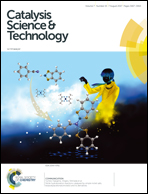Graphitic C3N4 nanosheet-sensitized brookite TiO2 to achieve photocatalytic hydrogen evolution under visible light†
Abstract
Brookite TiO2 was regarded as one of the most promising semiconductor materials in the field of photocatalytic H2 production. However, the low utilization efficiency of solar energy and high recombination rate of photo-induced carriers have hampered its application. To solve the issues stated above, novel g-C3N4 nanosheet/brookite TiO2 composite materials (TCN) with different contents of g-C3N4 nanosheets have been synthesized via an in situ TiO2 growth approach. The as-prepared TCN samples showed much higher visible-light-driven photocatalytic hydrogen evolution rate than pure g-C3N4 nanosheets. The optimal TCN sample with a g-C3N4 nanosheet content of 50% exhibited a H2 evolution rate of 68.76 μmol h−1, which was 1.55 times greater than pure g-C3N4 nanosheets and 6.8 times greater than bulk g-C3N4 under visible light irradiation. Results from X-ray diffraction, transmission electron microscopy and X-ray photoelectron spectroscopy suggest that close interfacial connections between g-C3N4 nanosheets and brookite TiO2 had been formed. Photoelectrochemical tests confirmed that the enhancement of photocatalytic H2 evolution activity resulted from superior electron transport and charge separation ability of the TCN composite materials.



 Please wait while we load your content...
Please wait while we load your content...